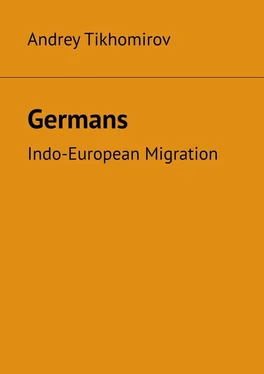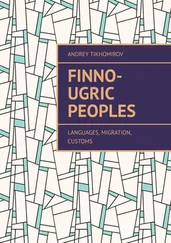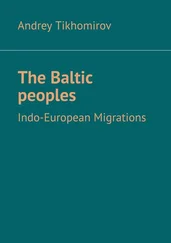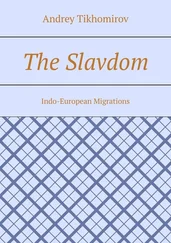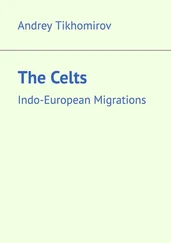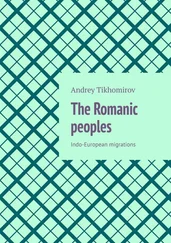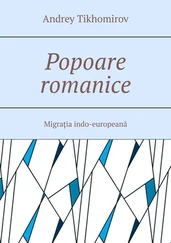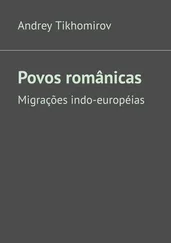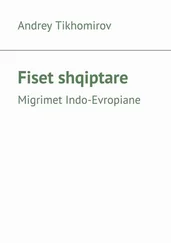Andrey Tikhomirov - Germans. Indo-European Migration
Здесь есть возможность читать онлайн «Andrey Tikhomirov - Germans. Indo-European Migration» — ознакомительный отрывок электронной книги совершенно бесплатно, а после прочтения отрывка купить полную версию. В некоторых случаях можно слушать аудио, скачать через торрент в формате fb2 и присутствует краткое содержание. ISBN: , Жанр: Языкознание, История, на английском языке. Описание произведения, (предисловие) а так же отзывы посетителей доступны на портале библиотеки ЛибКат.
- Название:Germans. Indo-European Migration
- Автор:
- Жанр:
- Год:неизвестен
- ISBN:9785005089809
- Рейтинг книги:3 / 5. Голосов: 1
-
Избранное:Добавить в избранное
- Отзывы:
-
Ваша оценка:
- 60
- 1
- 2
- 3
- 4
- 5
Germans. Indo-European Migration: краткое содержание, описание и аннотация
Предлагаем к чтению аннотацию, описание, краткое содержание или предисловие (зависит от того, что написал сам автор книги «Germans. Indo-European Migration»). Если вы не нашли необходимую информацию о книге — напишите в комментариях, мы постараемся отыскать её.
Germans. Indo-European Migration — читать онлайн ознакомительный отрывок
Ниже представлен текст книги, разбитый по страницам. Система сохранения места последней прочитанной страницы, позволяет с удобством читать онлайн бесплатно книгу «Germans. Indo-European Migration», без необходимости каждый раз заново искать на чём Вы остановились. Поставьте закладку, и сможете в любой момент перейти на страницу, на которой закончили чтение.
Интервал:
Закладка:
Germans
Indo-European Migration
Andrey Tikhomirov
© Andrey Tikhomirov, 2019
ISBN 978-5-0050-8980-9
Created with Ridero smart publishing system
The formation of the ancient Indo-Europeans in the Southern Urals – Black Sea
Modern archaeological research proves that the homeland of the Indo-Europeans is the region of the Southern Urals, where they formed as a single language group.
Communities are created, first on the basis of common origin – childbirth, and as marketable products increase, a large family community is formed, consisting of phratry, i.e. several genera. Then the neighboring community in the form of a tribe, the next step – the union of tribes, leading, in turn, to the formation of the people, and then the state. But for any community, a community of interests is also necessary, in this case, the protection of metallurgists and their products. So there were settlements of ancient metallurgists, and in particular, the Arkaim culture of the South Urals. Similar settlements were found in Europe, in Germany near Dresden and Leipzig, as well as in Austria and Slovakia, under the age of 7 thousand years. After the end of natural resources, the settlements were “closed”, the ditches were filled up, and the remains of the dwellings were burned.
The country of cities is the conditional name of the territory in the Southern Urals, within which ancient cities and fortified settlements of the Sintash culture of the Middle Bronze Age (about 2000 BC), one culture were found.
Settlements were discovered in the 70s – 80s. XX century. One of the first archaeological complexes found was an ancient settlement on the Sintashty River (a tributary of Tobol), due to which the settlement itself was named after the South Ural River. Soon after the discovery of other cities, archaeologists began to use the term “Sintashta culture.” This “country” is located in the Chelyabinsk region, Orenburg region, Bashkortostan and northern Kazakhstan. Cities are located on the territory with a diameter of 350 km.
All settlements are united by a similar type of structure, the organization of urban infrastructure, construction materials, and the existence time. As well as the same topographic logic. Fortifications are clearly visible in aerial photographs. After 4,000 years, the skeletons of cities clearly appear against the backdrop of the natural landscape, plowed fields. There comes an awareness of the skill of the engineers who designed and created such system cities. The cities themselves were most suitable for life. Firstly, they provided protection from external enemies, and secondly, in the cities premises were made for the life and work of artisans, saddlers, potters, and metallurgists. Inside the cities there is a storm sewer that takes water out of the settlement. Near the cities burial grounds were organized, animal pens were built. All fortified settlements were made in three different forms: round (8—9 pieces); oval (about 5); rectangular (about 11). The term “country” appropriately characterizes this location of cities. In addition to the fact that all the fortified settlements were built on a compact territory at the same time, in the same style and using the same engineering solutions, similar materials, other unifying properties are visible.
On the vast territory of the steppes in the ancient era to the west of the Urals, the tribes of the so-called Srubnaya lived, and to the east of the Andronovo culture, the latter covering the region from the Urals to Altai and the Yenisei. Andronovites, who spoke one of the dialects of the ancient Iranian language (Indo-European group), raised cattle and small cattle, horses, were engaged in fishing. In the southern Urals, traces of floodplain agriculture have been identified. Andronovo society was considered rather backward and archaic, as evidenced, in particular, by the poverty of their burials. In the grave, along with the deceased, they usually placed pottery, bronze jewelry, less often tools and weapons.
According to Videvdat (the first book of the Avesta, a collection of sacred books of the ancient Iranian religion, a kind of Iranian continuation of the Vedas), the ancestral home of the ancient Iranians is Airyanem Vaejah (Avest. Airyanem Vaejah, “Aryan space”). This country is described as the endless plain through which the beautiful river Daitya (Vahvi-Datiya) flows.
Indo-European tribes moved from east to west and, like a snow falling from a mountain, they swept away everything in their path, taking in those who joined their tribes. Their ancestral home, where they formed as a single language group, were the steppes of the Black Sea region – the Southern Urals.
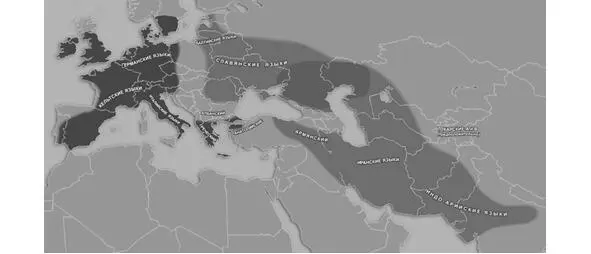
Indo-European areas of Kentum (blue) and Satem (red). The estimated initial area of satelliteisation is shown in bright red. Kentum-satem division is called isogloss in the Indo-European language family, related to the evolution of three rows of dorsal consonants reconstructed for the Pra-Indo-European language (PIE), * k-W (labio-velar), * k (velar), and * k; (chamber). The terms come from the words meaning the numeral “hundred” in the representative languages of each group (Latin centum and Avestan satem).
In the Avesta, the god Ahura Mazda (an extremely knowledgeable priest) advises the legendary immaculate king of the ancient Aryans (Indo-Europeans) Yime to create a giant fence – Varu, and there, for this fence put “the seed of all the males and females that are greatest on this earth, and the seed of all genera cattle, and the seed of all plants. And to do everything in pairs, while people are in Var … " The legendary Vara consisted of 3 circles, enclosed one in another. From the extreme 9 passages were conducted, from the middle – 6, from the internal – 3. And on this territory fenced off from evil winds, Yima built 18 streets, and created a window above the top – something like a chimney for smoke. The patron of forging in the Slavic pagan pantheon was the blacksmith god Svarog (Sanskrit. “Svarga” – heaven). The image of Svarog is close to the Greek Hephaestus and Prometheus.
The sun – Yes-God – in Slavic mythology was thought of as the son of Svarog. The ancient Slavic god – Dazhdbog – the bearer of happiness, most likely symbolizes rain, for example, in Slovak dažď (read “dazhd”) – rain. “Wind is blowing” is the analogy of a man who blows from his mouth. “Blind rain” means it is raining and the sun is shining, and so it turns out that it is as if the rain “does not see” and goes where the sun is shining. In the Christian folk calendar, Svarog turned into saints Kozma and Demyan – patrons of blacksmithing and marriage. The very presence of the gods – the patrons of forging – indicates the antiquity of its origin. With the word “Svarog”, the word “Swastika” (Skt.) Is idiomatically similar – a cross with ends bent at right angles, one of the oldest ornamental motifs found among the peoples of India, China, Japan, where the swastika sign also had religious significance. Compare also the Slavic words “cook”, “welding”. In the steppes of the Urals-Altai, forging has already reached significant development among the Scythian tribes of the Northern Black Sea Region (7—4 centuries BC), as well as among the Sarmatians and Slavs known in the 4th – 6th centuries. under the name of ants. In the 10—11 centuries. iron and steel products in Russia were widespread and had diverse applications. The ancient metallurgists usually concentrated in their hands both the smelting of iron from the swamp ore, the so-called “cooking” of iron, and the manufacture of various iron products, as well as the forging of copper, tin, silver and gold, especially in jewelry.
Читать дальшеИнтервал:
Закладка:
Похожие книги на «Germans. Indo-European Migration»
Представляем Вашему вниманию похожие книги на «Germans. Indo-European Migration» списком для выбора. Мы отобрали схожую по названию и смыслу литературу в надежде предоставить читателям больше вариантов отыскать новые, интересные, ещё непрочитанные произведения.
Обсуждение, отзывы о книге «Germans. Indo-European Migration» и просто собственные мнения читателей. Оставьте ваши комментарии, напишите, что Вы думаете о произведении, его смысле или главных героях. Укажите что конкретно понравилось, а что нет, и почему Вы так считаете.
